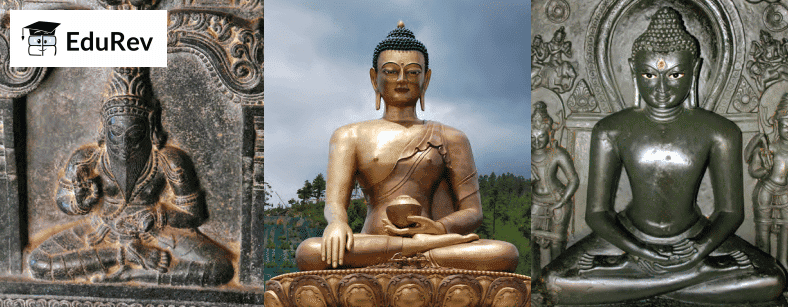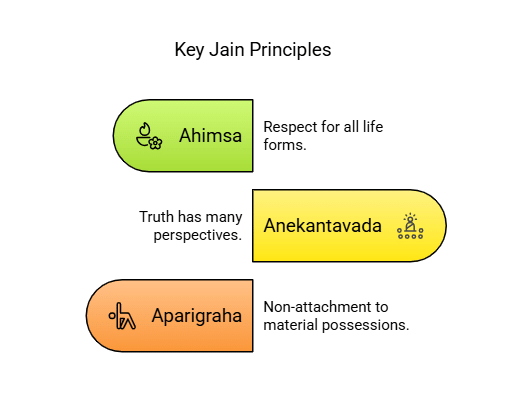Class 6 Exam > Class 6 Notes > Social Studies for Class 6 > Revision Notes: India's Cultural Roots
Revision Notes: India's Cultural Roots | Social Studies for Class 6 PDF Download
Introduction
- Indian culture is like an ancient tree with deep roots and many branches.
- Different fields like art, science, literature, medicine, religion, and governance stem from the same foundation.
- Culture evolved from Indus Valley Civilization, with many schools of thought shaping its uniqueness.

The Vedas and Vedic Culture

- The Vedas are India's oldest texts, containing hymns, prayers, and teachings.
- Written in Sanskrit, passed orally for generations.
- UNESCO recognized Vedic chanting in 2008 as part of humanity’s heritage.
Vedic Society
- Society was clan-based with limited governance information.
- Unity and truth were key values.

Vedic schools of thought explored rituals, philosophy, and spirituality, shaping key ideas like karma, rebirth, brahman, and self-realization.

Buddhism and the Teachings of Buddha
- Siddhartha Gautama (Buddha) was born in Lumbini (560 BCE approx.).
- He left his royal life after witnessing old age, sickness, and death.
- Attained enlightenment in Bodh Gaya, realizing suffering comes from ignorance and attachment.
- Founded Sangha, a community of monks and nuns.
- Taught ahimsa (non-violence), truth, and self-discipline.
- His teachings spread across Asia and influenced many traditions.

- Encouraged deep philosophical inquiry and self-exploration.
Jainism and Mahavira’s Teachings
- Jainism is older than Buddhism but gained popularity around the same time.
- Mahavira (6th century BCE) renounced his royal life to seek wisdom.
- Jain monks lived simple, ascetic lives, focusing on self-discipline and truth.

Folk and Tribal Influences on Indian Culture
- Folk traditions were passed through oral storytelling.
- Many tribal deities (e.g., Jagannath in Odisha) became part of Hindu traditions.
- Ancient tribes (janas) adapted to forests, mountains, and plains.
- 2011 Census: India has 705 tribes with 104 million people.
The document Revision Notes: India's Cultural Roots | Social Studies for Class 6 is a part of the Class 6 Course Social Studies for Class 6.
All you need of Class 6 at this link: Class 6
|
46 videos|246 docs|28 tests
|
FAQs on Revision Notes: India's Cultural Roots - Social Studies for Class 6
| 1. What are the main aspects of India's cultural roots? |  |
Ans. India's cultural roots are vast and diverse, encompassing various elements such as religion, language, traditions, festivals, arts, and cuisine. The country is home to multiple religions, including Hinduism, Buddhism, Jainism, and Sikhism, which influence its cultural practices. Additionally, India has a rich linguistic heritage with numerous languages spoken across different regions, contributing to a variety of literary and artistic expressions. Festivals like Diwali, Eid, and Christmas showcase the country's multiculturalism, while traditional arts like dance and music reflect its historical depth.
| 2. How do festivals in India reflect its cultural diversity? |  |
Ans. Festivals in India serve as a vibrant expression of its cultural diversity. Each festival has its unique significance, often rooted in religious beliefs and local traditions. For example, Diwali celebrates the victory of light over darkness, while Eid commemorates the end of Ramadan. Festivals often involve communal gatherings, rituals, and feasting, bringing people together regardless of their background. This not only showcases the rich tapestry of customs and practices but also fosters unity and harmony among different communities.
| 3. Why is language an important element of India's cultural heritage? |  |
Ans. Language is a crucial aspect of India's cultural heritage as it shapes identity, communication, and expression. With 22 officially recognized languages, each region of India has its linguistic nuances that reflect local history and traditions. Language plays a vital role in literature, storytelling, and oral traditions, preserving knowledge and cultural narratives passed down through generations. Furthermore, linguistic diversity promotes cultural exchange and understanding among different communities within the country.
| 4. How do traditional arts and crafts contribute to India's cultural identity? |  |
Ans. Traditional arts and crafts are integral to India's cultural identity, showcasing the skills and creativity of artisans across the country. Each region has its distinctive art forms, such as Madhubani paintings from Bihar, Warli art from Maharashtra, and pottery from Rajasthan. These crafts not only represent the aesthetic values of their respective cultures but also preserve historical techniques and stories. Additionally, they support local economies and encourage the continuation of traditional practices, reinforcing India's rich cultural legacy.
| 5. In what ways do India's cultural roots influence its modern society? |  |
Ans. India's cultural roots significantly influence its modern society in various ways, from social values to artistic expressions. The principles of tolerance, respect for diversity, and community bonding derived from cultural traditions continue to play a role in contemporary life. Moreover, traditional practices often find their place in modern celebrations, fashion, and cuisine, merging the old with the new. The ongoing dialogue between tradition and modernity helps shape India's unique identity on the global stage, allowing it to maintain its heritage while embracing progress.
Related Searches





















